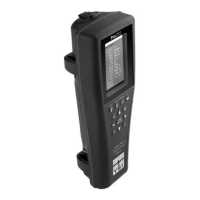38
Calibration
Turbidity Calibration 2-Point
Turbidity calibrations, more than most other paramters, are susceptible
to interference from contamination. It is critical for calibrations to be
performed with very clean sensors, guards, and cups.
NOTE: Calibration standards should not be re-used.
1. Fill the calibration cup to the appropriate level with 0 FNU
standard (deionized water may be used as a substitute). The
sensor guard must be installed to ensure an accurate calibration.
Make sure the guard is intalled and immerse the probe in the zero
standard.
2. Push the
Cal
key, then select Turbidity.
3. Select Calibration Value and enter 0.00.
4. Make sure there are no air bubbles on the turbidity sensor lens.
If present, lightly tap the guard against the cup to dislodge any
bubbles. Observe the actual measurement readings for stability
(white line on graph shows no significant change for 40 seconds),
and then select Accept Calibration. “Ready for cal point 2” will be
displayed in the message area.
5. Discard the used standard, and rinse the probe, guard, and
calibration cup with a small amount of the next calibration point
standard. Discard the rinse standard.
6. Fill the calibration cup to the appropriate level with fresh standard
for the second calibration point. Immerse the probe in the
standard.
7. Select Calibration Value and enter the value of the second
calibration standard.
8. Make sure there are no air bubbles on the turbidity sensor lens.
Observe the actual measurement readings for stability, and then
select Accept Calibration (Figure 54). “Ready for cal point 3” will
be displayed in the message area.
9. Select Finish Calibration to complete a 2-point calibration or
continue for the 3-point calibration.
Repeat steps 5 through 8 for a 3-point calibration. “Calibration
successful!” will be displayed in the message area. After calibration, rinse
with water and dry the probe.
Figure 54 Calibrate Turbidity

